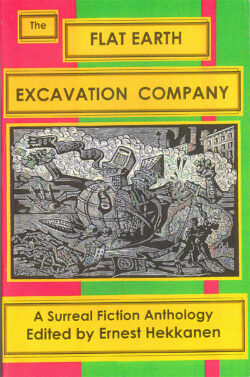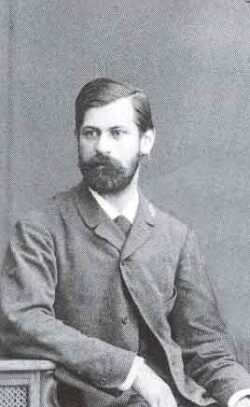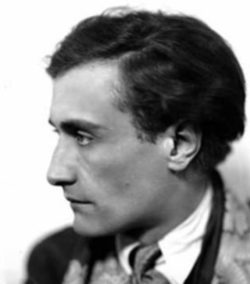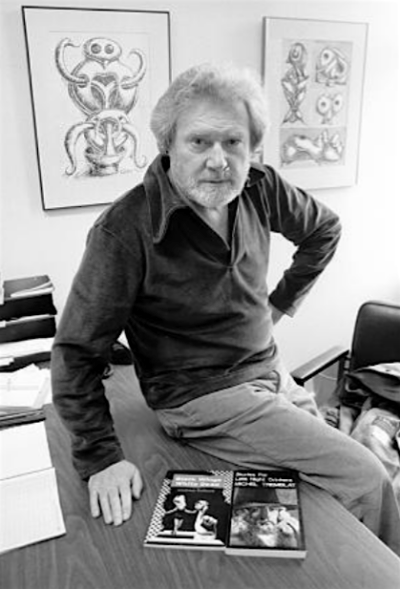1078 Hekkanen’s Kootenay Surrealism
Surreal Surrebutter Rebutter Sandwich Spread
by Ernest Hekkanen
*

Editor’s note: The archives of the New Orphic Review (NOR) are a popular part of The Ormsby Review website. Since 2018 all the back issues of NOR have been housed under our roof. Founded in 1998 by Ernest Hekkanen and Margrith Schraner, NOR was a semi-annual literary magazine published twice a year until 2017 by Hekkanen and Schraner in Nelson. All 40 issues — which are fully-searchable — are available here for browsing and consultation.
It is now our pleasure to present “Surreal Surrebutter Rebutter Sandwich Spread,” Ernest Hekkanen’s colourfully-titled introduction to his edited collection, The Flat Earth Excavation Company: A Surreal Fiction Anthology (Nelson: New Orphic Publishers, 2002). Hekkanen has described the book as an anthology of surreal fiction “spanning the length and breadth of surreal fiction–from automatic writing, or thought’s dictation, to stories that are fabulist, mythical, alchemical and even postmodern.”
Here, Hekkanen introduces the origins and impact of European Surrealism from its appearance in 1917, to André Breton’s Surrealist Manifesto (1924), and to Breton’s death in 1966, which is generally regarded at the end of the movement.
A handful of copies of The Flat Earth Excavation Company remain and can be obtained for $27.00 (which included postage) directly from Ernest Hekkanen by email — hekkanen[at]telus.net — or by writing to him at 706 Mill Street, Nelson, B.C., V1L 4S5.
*
 The wonderful thing about being a writer rather than an academic in the field of literature is the fact that I do not have to conform to the scholarly standards of my retentive colleagues. I can be a lot more creative and, indeed, imaginative in my thinking. I can break rules, stretch points, express improperly researched opinions and leap to groundless conclusions. My approach might strike one as rather surreal, but then, this book proposes to deal with the surreal in a surrebutter rebutter sort of fashion.
The wonderful thing about being a writer rather than an academic in the field of literature is the fact that I do not have to conform to the scholarly standards of my retentive colleagues. I can be a lot more creative and, indeed, imaginative in my thinking. I can break rules, stretch points, express improperly researched opinions and leap to groundless conclusions. My approach might strike one as rather surreal, but then, this book proposes to deal with the surreal in a surrebutter rebutter sort of fashion.
To fully understand and appreciate the surreal, one must understand what gave rise to it. One must realize how gridlocked European society had become, both socially and intellectually. In a gridlocked society, artists and writers must of necessity break the rules if they are to remain creatively alive. By the early 20th century, those who were to become the surrealists had begun to feel a pernicious dissatisfaction with Victorian society, rationalism and the industrial age, and for good reason.

Before I get any further into my examination of surrealism, it should not be overlooked that nearly all the important figures in the surrealist movement initially hailed from Europe. A partial list of surrealists would include André Masson, Jean Arp, Salvador Dali, Alberto Giacometti, Max Ernst, Luis Buñuel, Marcel Duchamp, Joan Miró, Jean Cocteau, Antonin Artaud, Georges Bataille, Louis Aragon, and, of course, André Breton, author of the Surrealist Manifesto of 1924. I would even lump into this surrealist stew playwrights such as Samuel Beckett, Eugène Ionesco, Friedrich Dürrenmatt, Luigi Pirandello, and perhaps even Bertolt Brecht.
One might argue that certain of these individuals are symbolists, dadaist or absurdists, but, in the end, such categories are more a fault of history than of anything else. What is important to see is that they all shared a similar disappointment with the constraints of realism and naturalism. Had symbolists such as Mallarmé, Maeterlinck, Verlaine and Rimbaud been born twenty or thirty years later, for instance, I am certain they would have joined the surrealist assault on the citadel of reason and convention. Similarly, if the absurdists had been born somewhat earlier, and hadn’t had to contend with parental authority figures in the surrealist movement, they might very well have become advocates of the surreal.
The mandate of the symbolists was to let symbolic images purvey the emotional and mystical content of their work. Having said this, it becomes more or less obvious that the symbolists were forerunners of the dadaists. One only has to consider that “dada,” in French, means hobbyhorse. A symbolic hobbyhorse can be metaphorically ridden into any desired allegorical landscape. An even more obvious connection exists between the dadaists and the surrealists, many of whom simply changed riding costumes. As for the absurdists, they were prepared to mount any tired old hobby horse that was still functional.
Much has been written about the prudish moral earnestness of Victorian society. By the late 19th century, victorianism was under siege and close to toppling. Everything held dear by its straight-laced representatives was being systematically challenged by rationalism. Rationalism, according to The New Oxford Dictionary of English, is “a belief or theory that opinions and actions should be based on reason and knowledge rather than on religious belief and emotional response.” Oddly enough, the rational views that vied with Victorian beliefs were cloaked in the same prudish moral earnestness as their counterparts. That is, rationalism was as straight-laced as victorianism. It was just as stuffy, rigid and earnest. It frowned upon frivolity and humour with as much zeal as did victorianism.
Rationalism and victorianism might seem like odd bedfellows, but somehow the two got down to bare essentials and gave birth to the industrial age. Rationalism contributed theories that were based upon reason and knowledge and those theories contributed to the material advancement of the species, in the form of applied science.
The material advances of society weren’t uniformly distributed. The middle and lower classes became servants of that which reason and knowledge had wrought. The lower class shovelled the coal that stoked the engines of the economy and the middle class made certain that those engines ran as efficiently as possible. The upper middle class and the aristocracy received most of the benefits, and those benefits included the leisure time necessary to indulge in art and literature.
By the early 20th century, rationalism had given rise to a bleak industrial landscape that had spread like a plague across Europe, dividing the haves from the have-nots. The powerful stood on their balconies, looked through field glasses at the resources arrayed before them – resources that were often located in other countries, by the way — and pondered how the energy of the lower classes could be employed to turn those resources into commodities.
Reason and knowledge – let that read, rationalism – had also made it possible to produce a magnificent array of weapons designed to maintain law and order, both domestically and internationally. Indeed, rationalism was inexorably moving civilized society toward the First World War of 1914 and the October Revolution of 1917. No matter how rationalism presented itself, whether under the guise of scientific materialism, capitalism, Darwinism or the scientific method, it proved flexible enough to adapt itself to just about anyone’s designs.
If one wants to coalesce the energy of the underclass, there is no better way to do it than by starting a war or a revolution. For the upper class, war is a chess game, a heroic way of dividing up goods and property, and every once in a while, it is necessary to indulge in war in order to revitalize the economy. War creates a demand for goods and expands the territory of the aggressor. For the underclass, war is simply another machine that needs to be stoked, usually with underprivileged bodies. Whether a worker loses his life in a mine, on the factory floor or on the battlefield, it is all the same to him. A machine is a machine is a machine, when one is in the position of feeding it one’s life.
In the middle of the First World War, and just one year prior to the Bolshevik Revolution of 1917, dada was launched in neutral Switzerland, by one Tristan Tzara. The dadaist movement included in its ranks such artists as Jean Arp, André Breton, Max Ernest, Man Ray, and Marcel Duchamp, to name but a few. Dada mocked existing artistic and social conventions and emphasized the illogical and the absurd.
It wasn’t by accident that dada emerged as a movement during the first big industrial war to be engaged in by Europe and that Zürich was chosen as its initial venue. In the face of widespread destruction caused by rationalism, artists and writers proposed to mount the hobby horse of dadaism and, with great frivolity and irreverence, ride into battle in a manner reminiscent of Don Quixote when he attacked the windmills; and in neutral Switzerland, one could conduct such an attack without incurring many casualties.

For the dadaists, war was the logical culmination of rationalism. This was especially true for Marcel Duchamp, one of dada’s angriest advocates. Duchamp had raged against the “machine” prior to the First World War, and now the mechanized mass killing on the battlefield fuelled his anger until it was white hot. Nothing was safe from his criticism, for everything wrought by civilization was the result of inhumane rationalism. No matter how much human beings tried to base their actions on reason and knowledge rather than religious belief and emotional response, and regardless of how civilized they pretended to be, they resorted to some rather barbaric behaviour in times of war.
In other words, rationalism had proved itself to be a sham. Our mundane daily lives as well as the international lives of nations were governed by impulses that human beings declined to recognize, largely because those impulses rose up out of the unconscious. The only way to fight rationalism was by exposing it for what it was — a crock of lies. The dadaists would do this by mocking the conventions of rationalism and by flinging in rationalism’s face its absurd consequences. Even art and literature suffered at dada’s hands.
Needless to say, the Quixotic knights who rode the hobby horse of dadaism into battle were highly romantic in nature.

A parallel movement had been going on in the science of human behaviour, one that was equally romantic. It was spearheaded by Sigmund Freud, a contemporary of the symbolists and dadaists. Freud suspected victorianism and its antithesis, rationalism, of harbouring some rather irrational responses – if not, in fact, a death wish. André Breton seized upon Freud’s notions, especially those having to do with sexual repression, and used them for his own purposes. A lieutenant in the ragtag squadron of dadaism, he desired to be a general in a much grander army of his own making. In his manifesto of 1924, he raised the flag of surrealism, with the fervent hope that others would rally around it, and they did.
In the Surrealist Manifesto, Breton states that art should be “pure psychological automatism … thought’s dictation, in the absence of all control exercised by reason and outside all aesthetic or moral preoccupations.” Gone, in other words, was the hobby horse of dadaism. Anarchy would now prevail, and all aesthetic and moral considerations would be tossed aside. In Breton’s assault upon convention, anything that reason had wrought had become the enemy of artistic expression.

When we ponder the objectives of surrealism and consider the revolutionary language that was being employed, we would expect its practitioners to resemble wild-eyed, scruffy, Molotov cocktail-throwing zealots, but on the contrary, upon viewing photographs of the main participants, one is struck by how cultured, civilized and, indeed, Victorian they appear to be. There isn’t a wild-eyed one among them. In fact, one begins to suspect that there was a lot more posturing than there was outright defiance, revolt or gross indecency.
It is difficult to read the Surrealist Manifesto without hearing echoes of similar manifestoes of the same vintage. There is a political edge to Breton’s missive, despite the fact that it deals with the arts. My own feeling is that Breton purposefully overlooked the fact that one can’t write a manifesto that purports to put aside the “control exercised by reason” in favour of something called “automatism” or “thought’s dictation,” and still present a coherent argument. Indeed, I suspect that Breton not only wanted to be coherent, but inflammatory. He wanted to be taken seriously by his enemies – that is, by the advocates of reason. In fact, he wanted reason to shake in its boots, and to shake in its boots for very good reasons of his own.

My own feeling is that Breton was little more than an opportunist who decided to take advantage of a situation that presented itself to him. The dadaist movement comprised a ragtag assortment of artists who needed to be organized into a militia and Breton thought well enough of himself to take on that job. From what I have read, he was not that easy to get along with. He didn’t suffer fools lightly and, in the course of his life, he would ferret out plenty of fools, expose them for what they were and then excommunicate them from the surrealist movement.
Not much of a writer or artist himself, he decided to become a general who would lead the attack on convention and any control exercised by reason. He was also a man who allowed himself to be governed by his passionate insights. A man whose passionate insights prove to be right each and every time is a man who finds it difficult to also tolerate free expression, and this seems to be the case with Breton. Those who failed to live up to the harsh code of “thought’s dictation” were viewed with suspicion by the chief advocate, judge and executioner of surrealism.

It must not be overlooked that Breton lived in an era when it was popular to write manifestoes. For instance, there was the manifesto of Marx and Engels, which proposed to deal with the ills of economics and of social class. Breton’s imagination, in many ways, was gripped by the pure automatism of his times just as much by pure psychological automatism. By the time he wrote the Surrealist Manifesto in the 1920s, it had become fashionable to pen diatribes in which one would set things straight, in which one would correct the ills of art, literature or society.
Oddly enough, surrealism and communism ended up becoming bedfellows for a period of time. The dictator of the proletariat and the dictator of the surreal found common cause in the assault upon reason and convention. Louis Aragon, one of the founding members of surrealism, followed Breton over to the communist camp. Indeed, Aragon eventually gave up surrealism in favour of the social realism advocated by the party of the proletariat. Antonin Artaud, on the other hand, viewed with great scepticism the political alliance forged with the communists and so cut his ties to the surrealist movement. The Theatre of Cruelty became his cause.

In the end, Breton was intelligent enough to discern that the communist assault troops were much better armed and, indeed, a lot more right-minded than were his surrealist assault troops, so the common cause became common no longer. Although Breton continued to hold Marxist beliefs, he knew better than to fully embrace communism. Indeed, when things got difficult for him in Europe, he fled to the United States. Given his conduct, one is forced to assume that he was imaginative enough to conceive of what would have become of him under a communist regime. Namely, he would have ended up with his back to a wall, facing a firing squad.
One of the contributors to this anthology, Michael Bullock, first encountered surrealism in 1936, at the impressionable age of eighteen. In a short piece entitled “The Essence of Surrealism,” he states that, “The essence of Surrealism, for those not familiar with its philosophy, lies in the attempt to reconcile the two opposites: the world of dreams and the unconscious (thesis) and reality (antithesis) in the synthesis, Surreality, on the same principles according to which Marx and Engels proposed to supersede the opposition between capital (thesis) and labor (antithesis) in the synthesis of the classless society. This was one reason for the apparent accord that at one time seemed to exist between the Surrealist Movement and the Communist Party.”
The desire for synthesis was not the sole reason why the surrealist movement and the communist party were in apparent accord. After the First World War, fascism became increasingly popular in Europe. Fascists of that era were notorious for being rather conservative in their views. They preferred neo-classicism to dadaism, surrealism, expressionism, cubism, absurdism, futurism, and all the other artistic “isms” of the time. Indeed, such art movements were viewed by the fascists as degenerate. The only political movement of any size to oppose fascism was communism, and many of the artists destined to wear the label “degenerate” found it necessary to form an uneasy alliance with the communists, although, in the end, communism proved itself to be just as dictatorial as fascism. Indeed, the social realism that artists and writers were expected to subscribe to under the communist regime was similar to the neo-classicism of the fascists.
If one subscribes wholeheartedly to Breton’s missive that artists and writers should obey “thought’s dictation,” it isn’t difficult to understand how “thought’s dictation” might get one into trouble with authorities on the communist left or the fascist right, or even into trouble with Breton himself. For the most part, artists and writers aren’t keen on marching to tunes played by dictators, no matter the political stripe of the dictator. Michael Bullock says in The Essence of Surrealism: “It must be admitted that both Surrealism and Communism failed in their objectives, but at least Surrealism brought about an unparalleled freedom in the arts that is unlikely ever to be reversed.” In the end, Breton’s grip on the surrealist movement couldn’t be maintained, due to the fact that Breton himself was something of a tyrant and the aim of surrealism was to get beyond the control exercised by reason and moral preoccupations.

At Carl Jung’s funeral service in 1961, the presiding protestant pastor remarked that the esteemed psychoanalyst was “a prophet who had stemmed the flood of rationalism and had given man the courage to have a soul again.” In Zürich, where dada received its official début, it is interesting to note that Jean Arp and Carl Jung moved in circles that generously overlapped. Increasingly, Carl Jung’s view of the collective unconscious became the one preferred by surrealists who continued to follow “thought’s dictation.” Jung’s view of the unconscious was less rigid, and consequently a lot more freewheeling, than the view of Sigmund Freud.
My own feeling is that Carl Jung was a well-meaning fraud. He falsified case histories and distorted what he found in various mythologies in order to serve his theories. He wasn’t, in fact, much of a scientist. However, he was a fabulous fiction writer, and I stand in awe of his ability to get followers and disciples to suspend their disbelief – at least long enough to acquire degrees in Jungian Analysis or Process Work. “Thought’s dictation” resulted in him writing Seven Sermons to the Dead, in which a pastiche of allegorical characters present themselves to him like walk-ons in a badly written play by someone trying to imitate Bernard Shaw’s Man and Superman. I suspect automatic writing also played a significant role in other books by Jung, ones such as Symbols of Transformation, The Archetypes and the Collective Unconscious, and Memories, Dreams, Reflections. The free association that he practiced in his own work is the same sort of free association valued by surrealists, and who can say for certain that Jung’s tomes aren’t simply mammoth works of surreal fiction.
The fact that Jung was eulogized as “a prophet who had stemmed the flood of rationalism” is probably the key to his appeal, even to this day. There is something in human nature that stands in defiance of reason and knowledge. We like to think that the soul is beyond analysis, beyond the probing of rational thought. It is difficult to know for certain, but perhaps there is an immutable something in us that we cannot fully comprehend. Certainly, there are ancient traditions which suggest that there is a considerable amount of undiscovered territory in the mind and all we have to do is wake up to the existence of it.

When Michael Bullock states that surrealism is a philosophy that attempts to reconcile the unconscious (thesis) with reality (antithesis) in a synthesis, surreality, I am reminded of Guillaume Apollinaire’s decision in 1910 to dub certain painters Orphists. According to Virginia Spate:
The Orphists conceived of their art as an expression of “modern consciousness” and were influenced by contemporary science, technology, literature, and philosophy as well as by the actual experience of living in the contemporary world. Their awareness of this world was of such complexity that it could not be embodied in structures which show only finite things in one place at one moment in time. They wanted to express what was called “simultanism”, the mind’s grasp of the simultaneous existence of an infinitude of interrelated states of being.[1]
Apollinaire’s decision to dub certain painters Orphists did not go over very well with the artists themselves. Later, just a few years before his death in 1918, he would coin a term that would have greater longevity in the world of art and literature, and that term was surrealist. In fact, after his death, he became the patron saint of surrealism. However, like most saints who come to occupy a firm place in the heavens, he probably looked down in wonder and dismay at what he had wrought on earth.
In the ancient Orphic tradition that gave rise to Pythagoreanism in approximately 550 B.C., “theory” was little more than a method that allowed one to acquaint oneself with the essence of things. In his weighty tome, History of Western Philosophy, Bertrand Russell has this to say:
[Theory] was originally an Orphic word, which [F.M.] Cornford interprets as “passionate sympathetic contemplation…” For Pythagoras, the “passionate sympathetic contemplation” was intellectual, and issued in mathematical knowledge. In this way, through Pythagoreanism, “theory” gradually acquired its modern meaning; but for all who were inspired by Pythagoras it retained an element of ecstatic revelation.[2]
By practicing “theory” one could reach a state of ecstatic revelation that allowed consciousness to pervade the object of meditation and know its essence. Thesis and antithesis attained synthesis in the cauldron of consciousness. Very esoteric-sounding, that, and very difficult to attain, I would think. It is this state of synthesis that the surrealists hoped to tap into, and failing that, at least to evoke in their work. That understanding has largely been lost. Nowadays, mere expression, no matter how poorly crafted or ill-conceived, is considered to be much more worthy than anything that has do with synthesis.
Surrealism hasn’t disappeared. It continues to be practiced, and now and then certain practitioners come to the attention of the general public, usually when the public tires of conventional literature and looks for something a little more novel. This happened in the 1960s and seventies, when writers such as Donald Barthelme and John Barth were in vogue. Such writers surface when we have grown weary of conventional ways of seeing the world, and here in this book, there is ample proof of that. At least, I think there is.
Before I leave you I would like to elaborate on two further thoughts. The title of this book, The Flat Earth Excavation Company, came to me first and the idea for the anthology second. I had intended to write a story in which a colony not unlike a penal colony would be stationed on an asteroid with the intention of mining its resources, only to dig all the way through the asteroid to the other side and thereby discover the emptiness of human endeavour. That notion struck me as rather surreal, and so the title of this anthology was born.
The title of the introduction you have nearly finished reading, namely “Surreal Surrebutter Rebutter Sandwich Spread,” was in part inspired by Jean Arp. Oftentimes, when Arp sent his hand-written poems to the printers, they would come back with “corrections” — due to the fact that his handwriting was sometimes messy to the point of being indecipherable. For him, the corrections supplied by the printers were acts of free association that resulted in the final poems. Likewise, when I sat down to write this introduction, I looked up the word “surrealism” in the dictionary, only to have my gaze fall on the word “surrebutter.” “Surrebutter,” I thought to myself. “It could be a sandwich spread. I like it. I think I’ll put it in the introduction.” However, in a curious way, the surrebutter — dialogue engaged in by the plaintiff and the defendant in a court of law — is symbolic of the chatter that is always going on in our heads, except, perhaps, when we are in a state of passionate sympathetic contemplation, when the chatter ceases and we actually know.
*

Born in Seattle in 1947, Ernest Hekkanen came to Canada in 1969. He writes: “When Margrith Schraner and I started our literary journal, The New Orphic Review, back in 1998, we had just turned 51. I had written three novels. We were living in Vancouver, at Napier and Victoria Drive, and we were full of irrepressible — dare I say youthful — optimism. Literature, for me, had become a matter of defying the odds. To create a product for which there would be an extremely limited market, if any at all, seemed to me an act of defiance worth pouring some hard-earned cash into. In the spring of 2016, NOR suffered a cryptolocker cyber-attack. I chose not to be held to ransom, despite the fact that it meant losing all of my active files.” Editor’s note: The Farewell Issue of the New Orphic Review appeared in Fall 2017. All 40 issues are now digitised and available for free on-line viewing and reference here.
*
The Ormsby Review. More Books. More Reviews. More Often.
Publisher and Editor: Richard Mackie
The Ormsby Review is a journal service for in-depth coverage of B.C. books and authors. The Advisory Board consists of Jean Barman, Wade Davis, Robin Fisher, Cole Harris, Hugh Johnston, Patricia Roy, David Stouck, Maria Tippett, and Graeme Wynn. Scholarly Patron: SFU Graduate Liberal Studies. Honorary Patron: Yosef Wosk. Provincial Government Patron since September 2018: Creative BC
“Only connect.” – E.M. Forster
Endnotes:
[1] Virginia Spate, Orphism: The Evolution of Non-figurative Painting in Paris 1910-1914 (Oxford University Press, 1979), p. 3
[2] Bertrand Russell, History of Western Philosophy (London: George Allen & Unwin, 1961), p. 52
